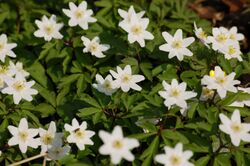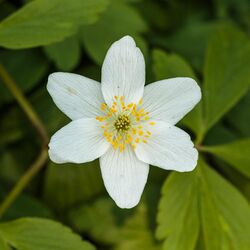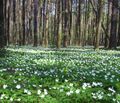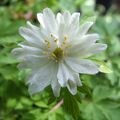Biology:Anemone nemorosa
| Anemone nemorosa | |
|---|---|

| |
| Scientific classification | |
| Kingdom: | Plantae |
| Clade: | Tracheophytes |
| Clade: | Angiosperms |
| Clade: | Eudicots |
| Order: | Ranunculales |
| Family: | Ranunculaceae |
| Genus: | Anemone |
| Species: | A. nemorosa
|
| Binomial name | |
| Anemone nemorosa | |

| |
Anemone nemorosa, the wood anemone,[1] is an early-spring flowering plant in the buttercup family Ranunculaceae, native to Europe. Other common names include windflower, thimbleweed, and smell fox, an allusion to the musky smell of the leaves. It is a herbaceous perennial plant growing 5–15 centimetres (2–6 in) tall.
Description
Anemone nemorosa is a rhizomatous herbaceous perennial plant less than 30 centimetres (12 in) in height. The compound basal leaves are palmate or ternate (divided into three lobes).[2]:106 They grow from underground root-like stems called rhizomes and die back down by mid summer (summer dormant).
The plants start blooming in spring, March to May in the British Isles[3]:28 soon after the foliage emerges from the ground. The flowers are solitary, held above the foliage on short stems, with a whorl of three palmate or palmately-lobed leaflike bracts beneath. The flowers are 2 centimetres (0.8 in) diameter, with six or seven (and on rare occasions eight to ten) tepals (petal-like segments) with many stamens. In the wild the flowers are usually white but may be pinkish, lilac or blue, and often have a darker tint on the backs of the tepals.
Similar species
The yellow wood anemone (Anemone ranunculoides) is slightly smaller, with yellow flowers and usually without basal leaves.[2]
Wood sorrel Oxalis acetosella, which grows in similar shaded places, can be readily distinguished by its ternate and clover-like leaves and smaller flowers with 5 white petals and 5 sepals.[3][4]
Pollination
The flowers are pollinated by insects, especially hoverflies.[5] The seeds are achenes.[2]
Medicinal uses
The plant contains poisonous chemicals that are toxic to animals including humans, but it has also been used as a medicine. All parts of the plant contain protoanemonin, which can cause severe skin and gastrointestinal irritation, bitter taste and burning in the mouth and throat, mouth ulcers, nausea, vomiting, diarrhea, and hematemesis.[6]
Habitat
Common in shady woods.[4]
This species spreads very slowly in UK forests, by as little as six feet per century, so it is often used as an indicator for ancient woodland.[7]
Distribution
Common in the British Isles.[3]
Cultivars
Many cultivars have been selected for garden use, The RHS Plant Finder 2008–2009 lists 70 cultivars of Anemone nemorosa sold by nurseries in the UK. Some of the most widely available are:
- 'Alba Plena' - double white
- 'Allenii'agm[8] - large lavender-blue flowers, often with seven petals (named after James Allen, nurseryman)
- 'Bowles' Purple' - purple flowers (named after E.A. Bowles, plantsman and garden writer)
- 'Bracteata Pleniflora' - double, white flowers, with green streaks and a frilly ruff of bracts
- 'Robinsoniana'agm[9] - pale lavender-blue flowers (named after William Robinson, plantsman and garden writer)
- 'Royal Blue' - deep blue flowers with purple backs
- 'Vestal'agm[10] - white, anemone-centred flowers
- 'Virescens'agm[11] - flowers mutated into small conical clusters of leaves
Those marked agm are recipients of the Royal Horticultural Society's Award of Garden Merit.
Anemone × lipsiensis, a hybrid between A. nemorosa and A. ranunculoides, has pale yellow flowers; A. × lipsiensis 'Pallida' is the best-known result of this cross. It has also been awarded the AGM.[12]
Gallery
References
- ↑ https://www.biolib.cz/en/taxon/id38358/
- ↑ 2.0 2.1 2.2 Stace, C. A. (2010). New Flora of the British Isles (Third ed.). Cambridge, U.K.: Cambridge University Press. p. 88. ISBN 9780521707725.
- ↑ 3.0 3.1 3.2 Clapham, A.R., Tutin, T.G. and Warburg, E.F. (1981). Excursion Flora of the British Isles (3 ed.). Cambridge University Press. ISBN 0521232902.
- ↑ 4.0 4.1 Parnell, J. and Curtis, T. 2012. Webb's An Irish Flora. Cork University Press. ISBN:978-185918-4783
- ↑ Blank, S. and M. Wulf. Investigations on seed production and pollinator biology of Anemone nemorosa (Buschwindröschen). Leibniz-Centre for Agricultural Landscape Research (ZALF). 2008.
- ↑ Symptoms of Plant poisoning - Protoanemonin. RightDiagnosis.com
- ↑ Plantlife - Wood Anemone
- ↑ "Anemone nemorosa 'Allenii'". RHS. https://www.rhs.org.uk/Plants/26686/Anemone-nemorosa-Allenii/Details. Retrieved 12 April 2020.
- ↑ "Anemone nemorosa 'Robinsoniana'". RHS. https://www.rhs.org.uk/Plants/92481/Anemone-nemorosa-Robinsoniana/Details. Retrieved 12 April 2020.
- ↑ "Anemone nemorosa 'Vestal'". RHS. https://www.rhs.org.uk/Plants/94034/Anemone-nemorosa-Vestal-(d)/Details. Retrieved 12 April 2020.
- ↑ "Anemone nemorosa 'Virescens'". RHS. https://www.rhs.org.uk/Plants/96660/Anemone-nemorosa-Virescens/Details. Retrieved 12 April 2020.
- ↑ "Anemone × lipsiensis 'Pallida'". RHS. https://www.rhs.org.uk/Plants/78860/Anemone-x-lipsiensis-Pallida/Details. Retrieved 12 April 2020.
Further reading
- Shirreffs, D. A. 1985. Anemone nemorosa L. Journal of Ecology 73: 1005-1020.
- Philip, C.. Plant Finder 2008-2009. ISBN 978-1-4053-3190-6.
- Plantlife - Wood Anemone
Wikidata ☰ Q161056 entry











